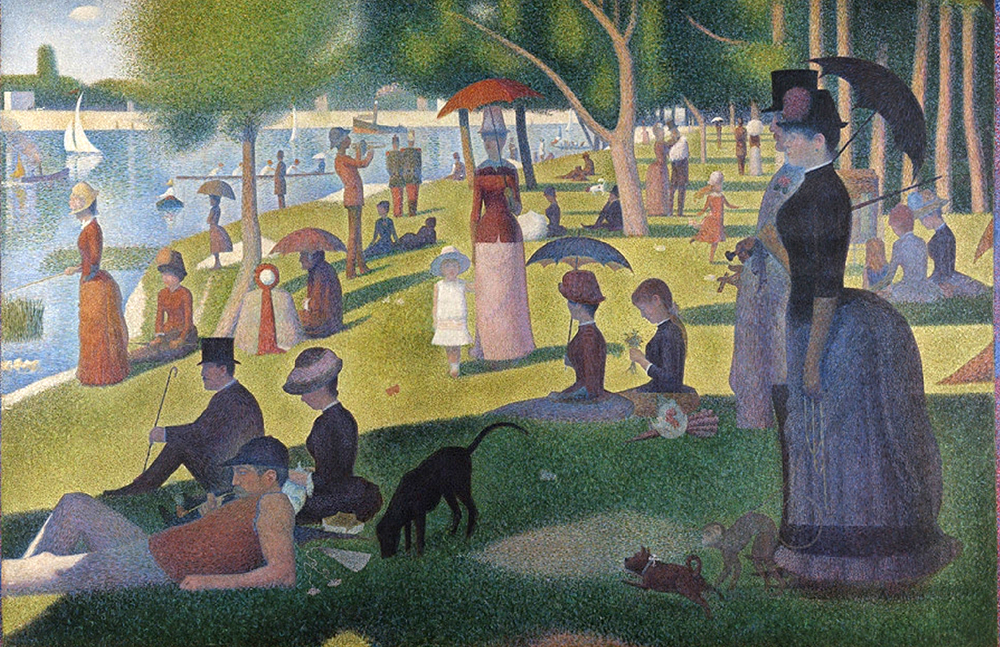
George Seurat, A Sunday Afternoon on the Island of La Grande Jatte, 1884–1886. (The Art Institute of Chicago.)
When I was young, I wanted to be an actor. I wanted to be an actor because I wanted to try on other personalities, to inhabit other peoples’ lives. If I memorized someone else’s sentences, I reasoned, I could discard them at the end of the evening. If I dressed in someone else's clothes, my logic continued, I could channel a personality through my body. You make the character move, and more importantly, it moves you.
And then you move on.
An actor pretends, but is not a puppet. Character comes alive not because of those lines and those clothes but because the actor’s own character breathes life into it. Each intersection between actor and character is different. Each night of a performance is different. Yet somewhere in the magical alchemy of all that productivity and performance lies a beautiful solo dance between the stage—and the self.
The faking of feelings, wrote Seamus Heaney, is a sin against the imagination.
When is pretending just another word for faking?
Pretending, when grounded in your own authentic spirit, is nothing more than the art of make-believe. You can—indeed, you should—try on other personalities, experiment with different vocabularies and voices. You just have to remember how to come back to center.
But perhaps it’s worth considering what it is you’re actually faking, here. Style? Substance? Influence? Affluence? Are you pretending to be productive by repeatedly redoing what you already know how to do, under the guise of sustaining consistency in your work? Are you doing just what you’re expected to do, what’s acceptable, if redundant? Worse—are you seeking inspiration from other peoples’ work—siphoning small parts of it as your own?
That’s called aping. Like an ape does. Or a parrot.
To wit: in his 1837 essay on nature, Emerson refers to the pantomime of brutes—and yes, he was referring, in this instance, to animals. But his nod to pantomime illustrates another facet of pretending: the idea of mirroring something—reflexively, and without cadence—imitation, if you will, as evisceration.
That’s called identity theft. Like a criminal does. Or a copyist.
Imitation, Emerson famously wrote, is suicide. No matter what your work, let it be your own.
The problem with present-day pretending is that it’s all too often driven by status and popularity. Long before the lure of mobile technology would make social media a theatre all its own, the psychologist Erving Goffman wrote about dramaturgical loyalty, which is what happens when you feel obligated to keep up appearances, playing the part you’re meant to play, even if it’s disingenuous. (The question of loyalty is a curious one. To whom are you loyal if not yourself?) Goffman’s thoughts on what he termed self-presentation theory made a strong case for the power of defined roles, which begs the question: is it still pretending if you stay in character?
And if you stay in character too long—are you faking it?
Stephen Sondheim, in one of the most beautiful passages from his theatrical masterpiece about the life of Georges Seurat, had a better idea. (And a deeply Emersonian one.)
Just keep moving on
Anything you do
Let it come from you
Then it will be new
Give us more to see
Maybe this is the big distinction. Faking is passive, an expression of lethargy. Pretending is active, an expression all its own. To resist those sins against the imagination is to see anew, and to see anew, you have to keep moving. Loyalty to that requires no puppetry, and needs no stage. Find—and hold tight—to that center. The pretending, and everything that comes with it, will find itself.
The Self-Reliance Project is a daily essay about what it means to be a maker during a pandemic. Sign up to get it delivered to your inbox here.

